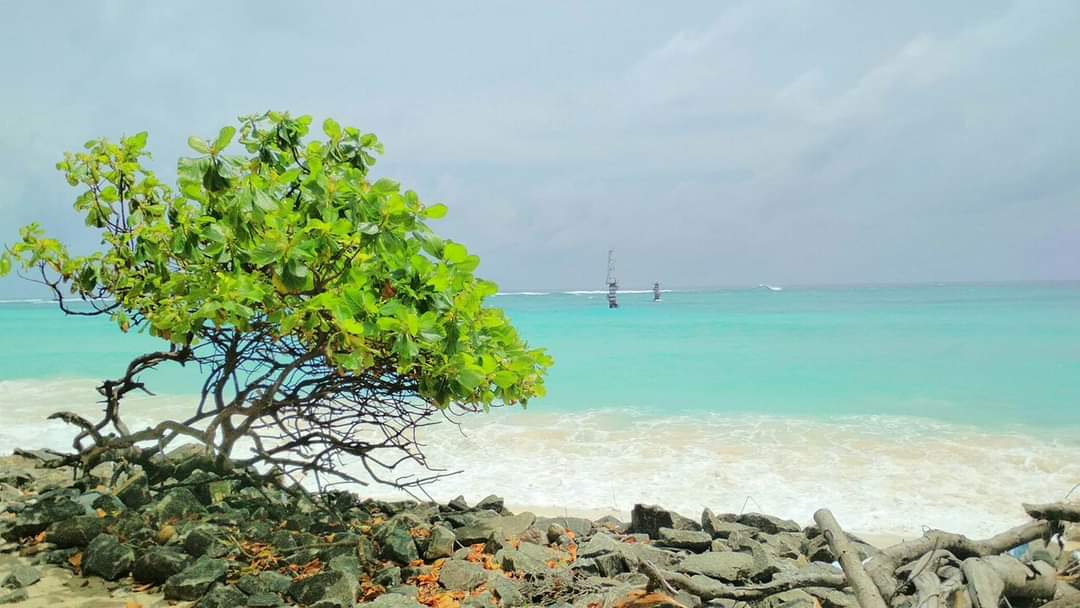Climate change to increase sea level in Lakshadweep Islands, will affect airport & residential areas: Study

Globally climate change presents unique challenges to Small Island Developing States (SIDS). The difficulties
that these small Islands face in effectively coping with climate change impacts are exacerbated in SIDS because
of their small geographical area, isolation and exposure. A recent study of the Lakshadweep islands in India shared alarming rates at which the Sea level is rising bringing to light that many such small islands suffer the same consequences even if they which do not belong to the SIDs officially and should be considered with the same outlines of mitigation and development as SIDs.
|| Elsie Gabriel
The study outlines that Sea-level will rise around the Lakshadweep Islands in the range between 0.4 mm/year to 0.9 mm/year, says a study conducted projecting different greenhouse gas scenarios.
The study highlights that the worst possible inundation scenarios projected for Lakshadweep Islands are almost similar under different emission scenarios projected and all the islands in the archipelago would be vulnerable to impact from sea-level rise.
One of the major threats in the coming years is rising sea level and its significant impact on small islands and this is for the first time, that climate model projections were used to assess the potential areas of inundation over the archipelago of Lakshadweep Islands in the Arabian Sea.
Over the years global warming and climate change proponents have established that because of Small Islands Nations low lying, ocean-fronted borders, relatively small land masses, and exposure to extreme weather and climate variability, island nations are especially vulnerable. As sea levels continue to rise, they surmise, islanders and cultures are being threatened. Lakshadweep Islands in India are no different. Although the islands do not come under the SIDs, they belong to India’s smallest Union Territory Lakshadweep which is very similar to SIDs as they are part of an archipelago consisting of 36 islands with an area of 32 sq km. It comprises of 12 atolls, three reefs, five submerged banks and ten inhabited islands. Ocean level rise amongst other climatic changes is threatening the very existence of these geographically isolated and small land masses.
A team of scientists including Aysha Jennath, Athira Krishnan, Saikat Kumar Paul, Prasad K. Bhaskaran jointly from the Department of Architecture & Regional Planning and Department of Ocean Engineering & Naval Architecture, IIT Kharagpur, with support from the Department of Science & Technology, Government of India under the Climate Change Programme (CCP), studied the Climate projections of sea level rise and associated coastal inundation in atoll islands, a ring-shaped coral reef or island.
The study estimated that smaller islands Chetlat and Amini are expected to have major land-loss. Projection mapping indicated that about 60%-70% of existing shoreline would experience land-loss in Amini and about 70%-80% in Chetlat. The present work highlights that, larger islands Minicoy and the capital Kavaratti are also vulnerable to sea-level rise, and expected to experience land-loss along 60% of the existing shoreline. Sea-level rise effects are seen to have the least impact on Androth Island under all emission scenarios.
Speaking to Prasad K Bhaskaran leading the study who outlined, “ A more detailed study is required to exactly draw up the solutions and mitigation measures for the same. For a more sustainable development of the infrastructure ecologically enhanced engineering and green infrastructure needs to be in place to address societal and biodiversity challenges.Designs should be in keeping with 30 years forsight. Breakwaters are recommended.”
The research that was published in the journal ‘Regional Studies in Marine Science, Elsevier recently showed that the coastal inundation could have wide socio-economic impact. According to the team, projected inundation due to sea-level rise can impact the islanders as residential areas are quite close to the present coastline. Also, the only airport in the archipelago is located at the southern tip of Agatti Island, and has a high likelihood of damage due to inundation from sea-level rise.
The team have suggested that keeping in view the impacts from projected sea-level rise for Lakshadweep, it is necessary to have appropriate coastal protection measures and best-practices to formulate planning guidelines.
“Proper coastal protection structures can be implemented to save the land from further inundation to reduce the wave impacts and erosion of the coasts,” suggested Athira Krishnan team member.
This study also opens up a new outlook and dimension on future research to assess the directional nature of wave energy, impact of storminess in the Arabian Sea region, islands that are exposed and sheltered and amenities such as potable water, sanitation and so on.
“Rising sea levels will threaten the freshwater resources there. In Lakshadweep groundwater is the source of freshwater and it exists as thin lens over the saline water. As sea level increases, there is going to be saltwater intrusion into groundwater and can make the groundwater unusable. Already due to heavy use the groundwater, Lakshadweep is in a critical state and very saline in many areas. Sea level rise will make it further worse.” Added Aysha Jennath from the team, elaborating on the threats of Sea level rise on fresh water sources.
This noteworthy study has practical value and can be immensely useful to policy makers and decision making authorities for both short and long-term planning that benefit the population in Lakshadweep Islands.
Having first visited the Lakshadweep islands in 2002,I have witnessed Island communities of Lakhshadweep over the years have shown immense resilience despite facing the threats of direct inundation as well as greatly magnified risks from storm surges, tidal flooding’s, extreme rain, and other effects of climate change on their livlihood and existence. Continued implementation of solutions by all stakeholders need to be expedited to keep not only rise in sea level but other impacts of climate change on these pristine islands in check.
According to the Intergovernmental Panel on Climate Change (IPCC) the sea level will rise about a meter (39 inches) by the century’s end, but this study finds that estimate to be conservative.
The results suggest that sea levels will rise about 25 centimeters (10 in) more per century if carbon emissions are not curbed and the Earth continues to heat up.
There is no ‘single solution fits all’ way out of this climate reality. Enhancing risk management measures with analysis of each of the ten inhabited Islands independently, aimed at multi pronged cross section approach is vital. It is of paramount urgency to unlock sustainable development pathways to reduce vulnerability and, mitigate environmental and socio-economic risks. Meanwhile halting deforestation,cutting down on fossil fuels, implementation of rain water harvesting, enforcing renewable energy sources and waste management, pressuring corporates to act on climate related risks, strengthening local indigenous community land rights as well as inclusivity in policy making with representation, ensuring job capacity enhancement of islanders, and holding government accountable is what you can do to combat climate change and contribute towards its mitigation.Techniques for the management and mitigation of such climate change hazards should simultaneously establish Applied Geo-Science Centers, Meteorological Services, Island Emergency Management in all respective ten Islands, urgently increase the availability and accessibility of financing to projects, and strengthen the legal and regulatory structures in the energy and environmental sectors in keeping with EIA in place.
Because like the small island nations,the Lakshadweep islands are one of the least polluting marine ecosystems and yet have to bear the harsh brunt of Climate Change.
Is Lakshadweep islands equipped to handle the impacts of the phenomenon?





